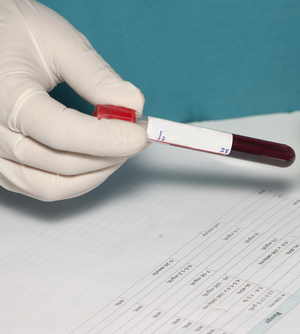Testosterone Levels During ADT May Predict Prostate Cancer Outcomes
A reduction in testosterone levels in the first year of ADT correlates with improved survival in prostate cancer patients being treated for biochemical failure.
Reduced testosterone levels during ADT were linked with improved survival. Image © Sherry Yates Young/Shutterstock.com.

A strong reduction in testosterone levels during the first year of androgen deprivation therapy (ADT) correlates with an improved survival in prostate cancer patients undergoing treatment for biochemical failure.
Men with prostate cancer who had testosterone levels ≤ 0.7 nmol/L had significantly longer survival and longer time to hormone resistance compared with men with higher testosterone levels (P = .015 and P = .02, respectively). Men who had testosterone levels consistently > 0.7 nmol/L had a greater risk of dying from their prostate cancer compared with men with lower hormone levels.
Those whose testosterone levels increased to ≥ 1.7 nmol/L developed castration resistance more quickly, compared with men whose hormone levels remained steadily ≤ 0.7 nmol/L.
The current analysis led by Laurence Klotz, MD, of Sunnybrook Health Sciences Centre at the University of Toronto, and colleagues analyzed the prospectively collected testosterone levels and clinical outcomes of the 1,386 men enrolled in the phase III PR-7 trial, which randomized men with biochemically recurrent prostate cancer after primary local therapy to receive either continuous (n = 696) or intermittent (n = 690) ADT.
The results of the analysis were published in the Journal of Clinical Oncology.
Prostate cancer patients with testosterone levels between 0.7 to 1.7 nmol/L were twice as likely to die from their cancer, and those with levels > 1.7 nmol/L were almost three times as likely to die compared with their counterparts who had testosterone levels ≤ 0.7 nmol/L.
ADT typically suppresses testosterone to castrate levels-a 90% to 95% reduction-but not all men achieve such reduction levels and others experience an increase in hormone levels while on ADT. Lower castration levels are defined as ≤ 0.7 nmol/L, but the clinical significance of testosterone levels in early-stage disease are still not well-understood.
Results of the PR-7 trial, published in the New England Journal of Medicine, showed that both intermittent and continuous ADT resulted in similar overall survival, but that several quality-of-life factors improved with intermittent dosing.
“The data from [this] study represent some of the strongest evidence to date that failure to achieve deep testosterone suppression after first-line ADT may herald poor outcomes in men with hormone-sensitive nonmetastatic prostate cancer,” wrote Daniel L. Suzman, MD, and Emmanuel S. Antonarakis, MD, of the Prostate Cancer Research Program at Sidney Kimmel Comprehensive Cancer Center at Johns Hopkins in Baltimore, in their accompanying editorial.
Based on the current analysis of the PR-7 trial, Klotz and colleagues recommend that men starting ADT should have their testosterone and prostate-specific antigen (PSA) levels checked regularly during the first year of therapy. They also recommend that if testosterone levels ≤ 0.7 nmol/L are not achieved during ADT, then the type of hormone therapy be changed.
But, the editorial authors believe that caution is warranted in interpreting these post hoc results because “the primary analysis of the PR-7 study showed that intermittent hormone therapy was non-inferior to continuous therapy with respect to overall survival.” Therefore, the importance of the further manipulation of testosterone levels in prostate cancer patients after ADT is still unclear. They also point to an ongoing trial, the SWOG-S1216 trial, which is currently evaluating the role of deeper testosterone suppression. “Until these or similar results are available, we should not recommend deeper androgen suppression in the first-line setting for men with (metastatic or nonmetastatic) hormone-sensitive prostate cancer,” concluded Suzman and Antonarakis.